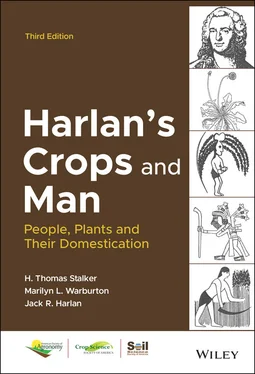What do the new studies show? To no one's surprise, they show that the golden age was more golden for some than for others. Even a few examples of famine were found (Johnson & Earle, 1987, p. 374). Brian Hayden (1981) listed a number of tribes showing a continuum of work from “a few minutes per day” (Tanaina in Alaska) or 2 hr per day (Hadza in Tanzania) to “all day every day” or “too busy to visit relatives” (Birhor in India). Well, I have been too busy to visit relatives even when I wasn't doing much of anything. It also comes as no surprise that if processing and cooking time is added to collecting time, it takes longer to get a meal than some figures would suggest. Processing some foods is laborious and time‐consuming. Grinding or pounding seeds into flour has always been drudgery, and boiling toxic foods in several changes of water takes a lot of time. Still, is watching a pot boil hard labor, especially if the kids make a game of picking up sticks to keep the fire going? And, of course, farmers must also process their food, too, so the addition of processing and cooking time does not necessarily change the comparison.
There are certain aspects of time and work that do not seem to receive due attention. Suppose you like your work? I always have, and have spent far more time at it than necessary for survival. Consider those men of industrial societies who spend endless hours cramped and freezing in a duck blind for little or no reward, or those who huddle in a shelter fishing through the ice in the middle of a Minnesota winter. The social aspects are what matter; after a few nips of whiskey, no one cares if the rod bends or not. I record two ethnographic notes from my own experience, both from farming societies, but the principles apply to anyone. Early one morning on a deserted road in Afghanistan, I came across a line of men dressed in colorful embroidered jackets, balloon pants, and pixie‐toed shoes. They had two drums and were singing and dancing up and down with their sickles in the air. A group of women followed, shrouded in their chadors, but obviously enjoying the occasion. I stopped and asked in broken Farsee: “Is this a wedding celebration or something?” They looked surprised and said: “No, nothing. We are just going out to cut wheat.” Harvest time is a good time of year even if it is hot and the “work” is hard. It is a time for socializing and, if the harvest is good, for celebrating.
A second observation was in eastern Turkey. My interpreter and I had seen a family harvesting a field and we stopped. He talked to the people while I collected some samples. My interpreter later told me that he had commented to the farmer that he could harvest the field in half the time if he would use a scythe and cradle. The farmer looked at him in astonishment and said: “Then what would I do?” There is a certain amount of Parkinson's law in all these activities. One fills up the time available. What is the meaning of time if there is more of it than you know how to use? As for getting by with the least effort possible for survival, I do not think that is human nature. Sure, anyone can drink vin ordinaire, but why not work a little harder and drink Chateauneuf‐du‐Pape?
How do hunter‐gatherers spend their leisure? Apparently they sleep a lot, but there are other diversions. Gambling is popular among many tribes; Woodburn (1970, p. 59) states that the Hadza people spend more time in gambling than in obtaining food. The most popular gambling stake is poisoned arrows. There are also music, dances, ritual and ceremony, rites of passage, playing cat's cradle, storytelling, creative arts, making useful and decorative articles, and similar activities. Life appears easy, but generally dull. Perhaps as a consequence there is a great deal of coming and going; the camp population is fluid and camps may be moved on the slightest pretext or for no reason at all. Understandably, there is a tendency to concentrate on the foods most easily obtained at a given time, and these are likely to change from season to season and, to some extent, from year to year. Groups of people in many gathering societies tend to be very fluid for that reason. When food is at maximum abundance, there is a tendency to gather in large bands. This is the season for rejoicing, celebrating, observing ancient tribal rituals, arranging marriages, and having naming ceremonies, coming of age ceremonies, and so on. The tribe is more fully represented at this time. During the most difficult season of the year, the people may break up into microbands to better exploit the gathering range and to avoid exhausting the food supply near the larger camps.
Many Australian Aborigines remain apart much of the yearly cycle even after becoming dependent on European agricultural–industrial systems. For most of the year they find jobs as ranch hands, laborers, mechanics, and so forth, but they may quit whatever they are doing, take off their store‐bought clothes, and take a three‐month “walkabout” during their traditionally festive season. Gathering is still easier than working at that time of year.
The study of hunting tribes that have survived long enough to have been observed by modern ethnographers is full of difficulties and pitfalls. Many tribes had become profoundly modified through contact with and by the pressures applied by agriculturalists. Some were reduced to the status of slaves or servants; others were restricted on reservations or their normal ranges were constricted by pressures of stronger groups. The social and economic structures of many tribes were in an advanced stage of disintegration at the time of ethnographic description.
The geographic distribution of surviving hunters results in a serious bias. By and large, hunters have survived where agriculture is unrewarding. We find them in the Kalahari Desert and adjacent dry savanna in southern Africa, in small pockets of tropical rain forest, in the frozen wastes of the Arctic, or in western North America, but there are no examples left in the more productive agricultural lands of the world.
At the time of European contact, the eastern forests and woodlands of North America were largely populated by native agriculturalists; the people living in the plains and westward mostly maintained hunting–gathering economies. There were enclaves of farmers, such as the Mandan on the Missouri River in North Dakota, and a highly sophisticated agriculture had developed in the Southwest USA where people practiced irrigation on a large scale and often lived in towns. Some farming was practiced along the Colorado River watershed and into southern California, but most of the California natives and other tribes of western North America lived by hunting, fishing, and gathering. A substantial body of information has been assembled about them, but we must remember that they did have contact with farming people and some of their cultural elements could have been borrowed.
Data for hunter‐gatherers in South America have been accumulating during the late 20th and into the 21st centuries. In the review by Scheinsohn (2003), she indicates distinct areas occupied by hunter‐gatherers in the grasslands of Argentina and southern Chile, farming communities in the highlands of western South America, and mixed hunter‐gatherer and farming societies in more mid‐to‐low land areas of Bolivia, Brazil, and Venezuela by about 6000 BP (Before Present). There is some evidence of man in South America by at least 30,000 BP (Scheinsohn, 2003), and these peoples were certainly hunter‐gatherers. The Bushman of southern Africa has been studied in some detail, but we know historically that they had long contact with the livestock‐herding Hottentot and farming Bantu tribes. The Congo pygmies often spend part of each year with agricultural people. The Ainu of Japan have taken up some farming in the last century or so. Many of the hunter‐gatherers of India are so constricted by agriculturalists that they have virtually become members of a nonfarming caste.
Читать дальше












